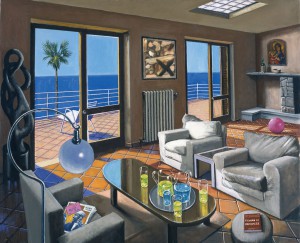In the title and in the painting itself, two things feel strange: that a painting could represent a notion of temporality; and a feeling of void. Is this the result of the disappearance of human characters?
They are somewhere there – many of them, as evidenced by the cocktail glasses, but no one is visible on the canvas. The simplification of this rather minimalist living room reinforces this impression of lightening up: it is probably a rented summer house with basic furnishing. Leisure activities are suggested: reading books or magazines, cocktails among friends, ball games, and an evocation of swimming through the view on to the sea.
The room itself, tiled like a swimming pool and with a glass ceiling, seems to have the function of bathing the spectator with light. The painting as a sundeck, where one immerses through contemplation. The hosts of the living room have works of art – abstract, informal. This is only normal: holidays are on a loose schedule.
Instead of the TV screen (Oh, no TV? This is really holiday time!) an old religious painting hanging right above the fireplace: holidays are a reflection of the 7th day of Creation.
Here is a painting about void, where figuration gainsays on conceptual abstraction as in Malevich: the terrible radicality of the white square on a white background, designed to be definitive, is thwarted there with irony and modesty by a “simple story” where fear is not excluded (see the possible effigy of a headlines about a terrorist event on the cover of a magazine: the course of world events, elsewhere, is not on holidays). This is “The time of holidays”, or rather “of vacations” – vacancy, or the Latin word otium illustrated by a Roman painter of today.
Christina Sourgins
Art historian
